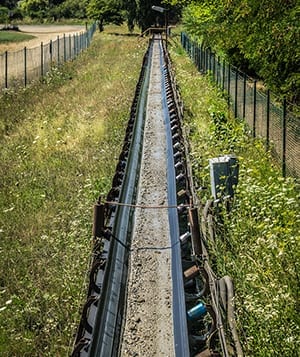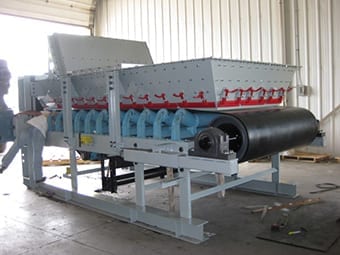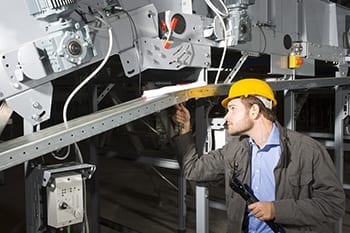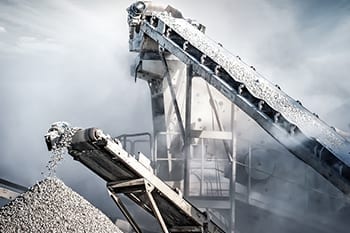Industrial Conveyors

A conveyor system is mechanical handling equipment that moves materials from one point to another. In applications that involve transportation of bulky or heavy materials, conveyors are used to allowing efficient and quick movement of materials. This has made conveyors popular in packaging and material handling industries.
Uses of Industrial Conveyors
The uses of industrial conveyors vary with the type of product being moved, distance and location. The conveyor standards define and measure maximum load, the flow of materials, speed, a number of pieces per time unit and load capacity.
Two types of conveyors are being produced in the market today; those that handle bulk materials and those that manage units of materials.
Belt Conveyor
 Belt conveyors move items between pulleys which have intermediate points for support. Belt conveyors can carry different materials, and their speed will vary with processing equipment and product needs.
Belt conveyors move items between pulleys which have intermediate points for support. Belt conveyors can carry different materials, and their speed will vary with processing equipment and product needs.
There are many ways that you contain products on belt conveyors. For example, ball transfer tables and air tables are used when you need to position the products. Additionally, they can be used to move materials from one conveyor line to other conveyor lines connected to it.
Bucket portion of the belt conveyor is made of a series of bins or buckets attached to an endless chain or belt.
Chain conveyors, chute conveyors, bucket elevators and cart and track conveyors help to get materials moving in the system.
Some conveyor belts have been designed to be sanitary for medical or food applications. Their use may include processes where they are sanitized. Their basic applications include the ability to eliminate microscopic deposits in the container or belt as well as ability to wash down surfaces.
Reciprocating Conveyors
This process uses a fork, cage or platform to move goods through different levels. It is not a continuous loop but a lower operation alternative lift. Additionally, you may also use augers to move loads through different levels.
Vibrating Conveyors
Vibrating conveyors are supported by drive system on hinge links and springs. Some have been designed so as to move items continuously. A good example is cleated conveyor on the inclined or horizontal plane.
Guidelines to Help You Choose a Conveyor System
Choosing the best conveyor system for your industry can be an overwhelming task. There will be many dilemmas you will face when trying to identify, purchase and develop the ideal material handling conveyor system.
Depending on your application needs, the conveyor system will vary from a simple system to one which is complex. This is why you have to ensure that the conveyor system has been designed with the following specific characteristics that help meet your needs:
- Ease to adapt to changing needs
- Safe to operate
- Reliable with minimal maintenance needs
- Energy efficient
- Cost effective when it comes to operation
 Conveyors have been devalued over time by a mindset that considers them last in the planning cycle. This is why they are among the last equipment to be purchased as the decision to buy usually based initial acquisition cost and not overall value.
Conveyors have been devalued over time by a mindset that considers them last in the planning cycle. This is why they are among the last equipment to be purchased as the decision to buy usually based initial acquisition cost and not overall value.
Commoditizing view of conveyors risks operations. When a suitable conveyor is applied in the wrong way, it will quickly undermine efficiency and long-term strategy absorbing your profits and stripping you of your competitive advantages.
So what will be the best approach as you search for the best conveyor system? The common requirement for a conveyor in distribution environments and warehouses is the ability to transport items or products between successive points so as to fulfill the process and balance workflow to different processes. Buffer accumulation will enable production during downtime downstream in your process.
The features you need to look out for as you choose your conveyor system include:
Flexibility
Search for conveyors that will easily accommodate the size of products especially those with greater widths. Also, buy those that will satisfy the demands you have today as well as accommodate those you will have in the future.
Safety
Some conveyors have inbuilt safety features while there are those that will require additional elements to safeguard the employees who directly use the equipment.
Modularity
Search for modularity regardless of the conveyor that you need for your business. Choose conveyors that have modules, sections which are pre – engineered and components that you can easily combine to a customized layout that can be reconfigured if necessary.
Scalability
Choose conveyors that will facilitate adaptability to change and increase growth. Your ideal conveyor system should incorporate flexibility and modularity so as to account for a range of product sizes and types as well as allow throughput over time. The conveyor system should also be easy to reconfigure or extend to adapt to your future needs or requirements.
Ergonomics
A conveyor system with proper ergonomics will create a better work environment, reduce operation injuries and increase productivity. Do not base your choice on typical guidelines rather on your workforce by knowing what makes sense to your operation.
Maintainability
 The conveyor system you choose needs to be one that you can easily maintain. The easier it is to maintain and repair, the less impact it will have on your operation when it breaks down. With proper maintenance, a conveyor system that has been designed well will last long. Common problems to look out for include:
The conveyor system you choose needs to be one that you can easily maintain. The easier it is to maintain and repair, the less impact it will have on your operation when it breaks down. With proper maintenance, a conveyor system that has been designed well will last long. Common problems to look out for include:
- Poor take up adjustments
- Contamination
- Lack of lubrication
- Bad belt timing or tracking
Reliability
Choose conveyor systems that have stood the test of time. Focus on the leading technology rather than the “bleeding” one. Look for conveyors that have been in operation for some time. Contact current and reference users to discuss reliability and performance over time. This means when it is down you will have more appreciation for it.
Know Your Product
It is critical that products that will be handled by your conveyor system. Design criteria need to be clearly identified and described:
- What product will be conveyed?
- Where are barcodes located on products?
- What are the dimensions of each product?
- What is “live” load of product?
Energy efficiency
Energy efficiency needs to be applicable to all types of conveyors. Something as simple as sleep mode during inactivity periods may result in significant saving.
Know the Needs of Your Conveyor System
 For a sustainable and efficient operation, it is important that you understand the requirements of your system:
For a sustainable and efficient operation, it is important that you understand the requirements of your system:
- How are orders being picked and being introduced to the conveyor system and at what rate?
- How many orders can you shift over time?
- What are your growth projections?
- What do require for the demanding hours of each day?
The answers that you give to these questions will help you determine the type of conveyor that will be appropriate for your operations. Additionally, they will help you determine designs speeds throughput requirements and speed to ensure requirements of production will be met by your conveyor system.
A conveyor system can be employed by your company to move products effectively and promptly. It can transform your operation and improve your efficiency tremendously. If you are interested in learning more about conveyors be sure to give us a call.
Project Gallery
Project Gallery
Truck Dump Project
Swanton Welding fabricated two truck dump platforms. These are used in various industries where semi or other large trucks are driven onto a platform for unloading. After securing the truck, the platform is raised high into the air, and the load on the truck is transferred via gravity into a bin or hopper. Our client builds […]
Project Gallery
Purification System Filter
Waste Water Separator This project’s client needed a water tight clarifier tank fabricated. We had to build, weld, leak test, shop assembly, blast, caulk, and paint the tank. In the end, we delivered a completed clarifier tank assembly. Completion Date March 7, 2017 Materials All materials were carbon steel Fabrication Methods This project utilized […]
Project Gallery
Ladle Maintenance Carts
Customer needed a way to conveniently transport large ladles to areas where they will be used.
Project Gallery
CE Boiler Stack Replacement
Swanton Welding was responsible to create a drawing based printed CAD drawings to design and fabricate a replacement stack out of A588 material for the refinery
Project Gallery
Accumulator Tower for Metal Coating Process
Structural Steel Tower This project consisted of constructing two similar towers. The entry side is pictured and the exit side can be seen in the distance. This new customer to Swanton Welding requested the project to be finish painted before it was delivered. These structural steel towers were assembled in the field and required very […]
Project Gallery
Clarifier Tank Project
At Swanton Welding, we have the expertise and resources to meet all your large scale project requirements at our state-of-the-art facility. As your trusted partner in welding and fabrication projects, we are committed to providing exceptional craftsmanship, reliable service, and timely project completion. An example of our capabilities is the recent construction of a sizable […]
Project Gallery
Stainless Steel Platform
Custom fabricated stainless structural steel platform with carbon steel columns and handrails.
Project Gallery
Double Drop Trailer
Swanton Welding Company was contracted to construct a double drop trailer for a client in Ottawa, OH. The project took under two months after a mid-July 2024 start, with completion in early September 2024. A double drop trailer, also known as a lowboy trailer, transports oversized loads considered too large for a standard trailer on […]
Project Gallery
Industrial Conveyor Fabrication
An agricultural industry client approached Swanton Welding & Machining to fabricate twelve, 5,000 lbs conveyor components. Utilizing AutoCAD 2009, we first drafted complete shop fabrication drawings of the component. We then fabricated the 20′ long, 3’6″ high and 8′ wide conveyor section using a CNC beam line, saws, and drills. After fabrication, during which we […]
Project Gallery
Bridge and Boardwalk
Swanton Welding was contracted to build a bridge and boardwalk for a client in Westfield, IN. Our estimation team and project manager worked with the client to make sure we provided an accurate and complete quote and timeline. This project took place from late May through late September of 2024. This bridge and boardwalk, weighing […]
Project Gallery
4100 Grillage Fabrication
Barge Stabilizer Swanton Welding took on a project with a simple goal: support a 1500 tons crane with two barges. The heavy duty steel frame binding the two barges together, and the crane would be used to drive in bridge pilings.
Project Gallery
Project Gallery
Bottom Casing for Glass Furnace
This custom fabrication project was for approximately 30 Bottom Casings for a Glass Furnace. Each section had to have pads custom machined to ensure it was within 1 mm of flatness. After the individual casings were completed, we had to shop assemble the entire length of them and use a transit to ensure their critical […]
Project Gallery
Support Structure
Swanton Welding is fully equipped to meet all your large-scale structural steel project requirements in-house at our cutting-edge USA facility. We take pride in being a dedicated partner in the success of every fabrication project we complete. Recently, we collaborated with a client based in South Carolina to construct a support structure. Given its critical […]
Project Gallery
Steel Thrustframe Fabrication
A customer from the gas exploration industry approached Swanton Welding & Machining to fabricate an A36 and A-514 steel thrustframe weldment. The 225,000 lbs weldment was fabricated using a variety of processes, including CNC milling, MIG welding, drilling, laser cutting, bending, tapping and forming. The 54′ long and 8′ wide thrustframe was skillfully fabricated using […]
Project Gallery
Replacement Boom
It is basically the structural arm for a heavy duty conveyor ship loader.
Project Gallery
Acid Furnace Fabrication
Swanton Welding & Machining was approached by a chemical industry customer to fabricate a 125,000 lbs. acid furnace. We first drafted complete shop fabrication drawings for the furnace using AutoCAD software. We then used a variety of fabrication methods to complete the A516 grade 70 and A-36 grade steel furnace, including: drilling, rolling, laser cutting, […]
Project Gallery
Steel Stack Fabrication
Swanton Welding & Machining was approached by a client from the clean air industry to fabricate 950,000 lbs. of steel stacks. Eight large stacks were fabricated using a variety of processes including rolling, bending, forming and MIG welding. The stacks were fabricated using a combination of material such as, A36 steel and 304 and 409 […]
Project Gallery
Catalytic Converter
Fabricated stainless steel Catalytic Converter w/ Pipe Bundle. A customer approached us about doing this job out of stainless steel with the stainless pipe bundle being made out of a special seamless tubing. The timeline was critical as the customer had a two day plant outage scheduled and they needed this unit installed during that […]
Project Gallery
Stainless Steel Hopper
We custom fabricated this stainless steel hopper and finished it off with a polished interior for food grade application.
Project Gallery
Fulton County Hospital Office Addition
Swanton Welding was tasked with fabricating the steel framework for the new Fulton County Hospital addition in Wauseon, Ohio. We appreciated the opportunity to support Rupp/Rosebrock, Inc. and their construction crews as they constructed a four-story medical building that will attach to Fulton County Hospital. The team at Swanton Welding used our beam line to […]
Project Gallery
Glass Furnace Rebuild – Support Steel
A client proposed and drew the initial design of this support steel project. It will encase and support a glass melting furnace for the engineered reinforcements industry. Swanton Welding supplied materials such as tie rods, platform steel, stairs, and ladders for the 20 ft tool glass melting furnace. Fabrication, blasting, and painting were customized to […]
Project Gallery
125 Ton Steam Car
We built a 125 Ton Steam Car. We fabricated it, blasted and painted it, did the assembly, electrical work, and shop tested it.
Project Gallery
1270 Dredge
Swanton Welding Company began working on this Dredge project in February of 2022 with a wrap-up in October of 2022. This dredge is a medium-sized dredge that offers excellent rates for dredging depths up to fifty feet. This type of dredge is typically used for ports, harbors, rivers, and inland waterway dredging projects, as well […]
Project Gallery
Discharge Hopper, Clarifier, Clarifier Structure, Catwalk & Stairs, Auger
We custom built a large Discharge Hopper, a Clarifier used to remove slurry, the Clarifier Structure, accessible Catwalk & Stairs, and a custom Auger for the Clarifier. The most interesting thing about this project was its overall size and the custom auger we built.
Project Gallery
CVG Airport Canopy
Fabrication of two large canopies out of steel tubing to be installed at an airport. The canopies were fully assembled in shop prior to shipping. Both canopies were hot dip galvanized to withstand the corrosive installation environment.
Project Gallery
Mixing Tank Fabrication
A customer from the water treatment industry approached Swanton Welding & Machining to fabricate a mixing tank assembly. The 50,000 lbs. tank assembly was made up of many different parts and systems including rapid mix, reactor and clarifier tanks, a 16′-8″ long platform, and a 15′ high draft tube. To fabricate these components and many […]
Project Gallery
Vertical Clarifiers with Thickeners
These were vertical clarifier tanks used to separate certain materials from water.
Project Gallery
Lamella Style Inclined Plate Clarifier
Swanton Welding was contracted to fabricate a Lamella Style Inclined Plate Clarifier that will ship to Mt. Holly, NC, when completed. This fabrication will serve as a wastewater clarifier for the facility in North Carolina. Swanton began this project in June of 2024, and it is currently ongoing. When completed, we expect the fully assembled […]
Project Gallery
Inclined Plate Clarifier
Swanton Welding Company recently completed fabrication of an Inclined Plate Clarifier with an integrated Thickening Tank, a large-scale build designed for industrial wastewater treatment. We delivered the final assembly to Blythewood, South Carolina, where it will be used to remove metals and paint solids from wastewater streams. This project kicked off on December 3rd and […]
Project Gallery
Tire Separator and Hopper
The project involved making a hopper & separator for a tire recycling plant. The hopper was designed to dump truckloads of used tires. It has a motor and sliding floor system that was sloped to feed the tires to the separator, which would separate the tires based on size and feed them to additional equipment […]